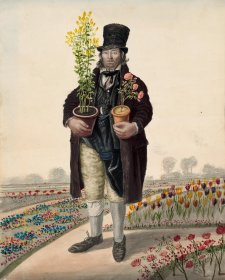Dempsey’s unnamed porter is waiting for custom in the coach yard of the Golden Cross, a coaching inn that once stood in the area now occupied by Trafalgar Square. The indefatigable recorder of London street life, George Scharf (1788–1860) lived nearby in St Martin’s Lane, and the coach yard is identifiable from one of his numerous sketches of the area. The Golden Cross was something of a favourite location for Charles Dickens: it features in the chapter ‘Early coaches’ in Sketches by Boz (1836), it is the place from which Mr Pickwick and his friends departed London for Rochester in The Pickwick Papers (1837), and where David Copperfield stayed on his arrival in London from Canterbury. Not long after Dempsey and Scharf recorded it, the ‘clutter of stables, inns, barns and “vile houses”’ at the south end of St Martin’s Lane was swept away as a result of the Charing Cross Improvement Act of 1826.
In the 1820s, porterage within the City of London was highly regulated. The number of licensed ‘ticket-porters’ was limited to 500. Like today’s taxidrivers, carriers were required to display official identification ‘when plying or working’ and could only offer their services at or within six yards (approximately six metres) of designated stands. Their fares were also set by the City, and ranged from fourpence to send ‘any Package, Letter, &c, not exceeding 56 lbs’ a quarter of a mile (400 metres), to two shillings and sixpence for a parcel ‘above 112 lbs and not exceeding 168 lbs’ to be taken two miles (three kilometres).
Despite his imposing bulk, it seems unlikely that Dempsey’s porter could manage that upper range — his left foot would appear to be badly swollen (with gout, perhaps?) and slippered for comfort. It is possible that he is, in fact, not a ticket-porter but part of the establishment of the Golden Cross or one of the nearby inns. This might also account for the absence of a visible ticket and the presence of an apron, as well as for the longevity of the man’s employment and for his consequent small celebrity.
Collection: Tasmanian Museum and Art Gallery, presented by C. Docker, 1956



Dempsey’s people: a folio of British street portraits 1824–1844 is the first exhibition to showcase the compelling watercolour images of English street people made by the itinerant English painter John Dempsey throughout the first half of the nineteenth century.



Visit us, learn with us, support us or work with us! Here’s a range of information about planning your visit, our history and more!



We depend on your support to keep creating our programs, exhibitions, publications and building the amazing portrait collection!